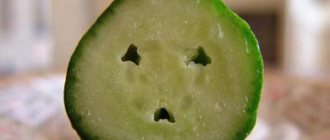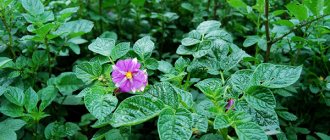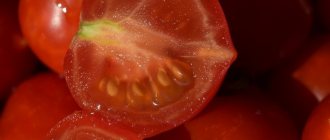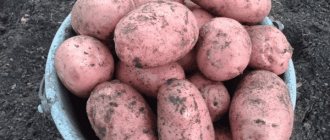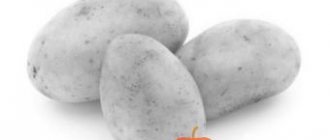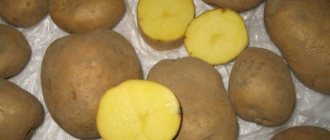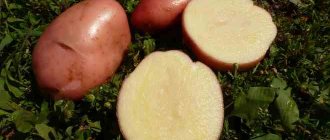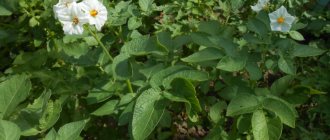How to properly store silver
A potato tuber is a nutrient-packed version of a bud.
Its goal is to germinate in the spring and form a new plant. This process starts when it gets warm enough. Sprouted tubers become less nutritious as starch is used up for germination. If the potatoes sprouted during storage, this means that the storage is too warm. Elevated temperatures can also develop in the depths of the stockpile if ventilation is insufficient. The sprouts are dangerous to eat, so they will have to be cut off. The potatoes must be sorted and placed so that the optimal amount of air enters.
So, to prevent germination, the room with the potatoes should be well ventilated and cool (but not too cold, otherwise the flesh will begin to darken).
Quite often potatoes turn black inside during storage, let’s find out why this happens:
- Potatoes become covered with dark spots when they are kept in a warm place for a long time or in a room with insufficient ventilation. Typically, the first manifestations appear after 1-2 months of improper storage;
- The normal storage temperature for potatoes is considered to be a range from 2 to 4 degrees with a plus mark; if the temperature is lower, the vegetable freezes; if higher, dark spots may appear.
In addition, it is worth saying that blackening of the pulp can occur due to the fact that you planted a variety that contains too much starch. The fact is that it is these varieties that suffer from this problem, most often this manifests itself during cooking of the vegetable.
Blackleg
This is an infectious disease that is transmitted from an infected tuber to a healthy one. Moreover, further spread of the disease can occur in the bags, when the potato crop has already been harvested and the fields are empty. Externally, this condition can be distinguished from gray spotting, because from the inside the tuber will turn black from the stalon.
Black spots initially cover the middle of the potato, later moving to the vascular branches, appearing on the peel. Also a distinctive characteristic of the disease is a characteristic unpleasant putrefactive odor. It is important to detect the problem early during the growing stage to prevent the spread of the disease.
Melanosis
Next we will talk about a disease such as melanosis. Externally, the tuber and peel of the affected crop will look normal, without changes, but at this moment the blackness continues to increase under the peel. It is worth saying that the affected vegetables remain suitable for food, which cannot be said about the previous disease - blackleg.
The reasons for the appearance of melanotic spots can be different, for example, mechanical damage to the vegetable.
Potato varieties with a high starch content in the pulp most often suffer from melanosis; it becomes dark more often than others. In addition, the development of the disease is accompanied by errors in choosing the harvest time. It is worth taking this aspect wisely, and also doing everything to avoid injuring the tubers during harvesting.
The cause of the disease can be high humidity
An excellent prevention of melanosis is placing beets in potato bags; it helps keep the potato pulp intact. The fact is that beet will help overcome the problem of excessive humidity in the place where tubers are stored.
Late blight
Another reason for the appearance of such spots on the pulp may be late blight. This disease occurs in any region, including the entire territory of Russia. A distinctive feature of the disease is that it affects not only the tuber, but the leaves of the plant. This fact greatly complicates pest control.
Signs of late blight
- Brownish spots and dots form on the leaves
- The leaves rot and then dry out
- The final stage is their fall
Causes of late blight
Infection with late blight occurs as follows and for the following reasons:
- Remains of weeds and other vegetation were not removed in time
- The seedlings were initially infected with a fungus
- Mistakes were made in the technology of growing potatoes.
It is worth saying that the scale of late blight damage is impressive; the disease spreads very quickly. The peak incidence occurs during the flowering period of the bush, although in most cases the period of infection can shift in one direction or another depending on weather conditions. The most favorable time for the reproduction and spread of the fungus is wet and damp weather - rainy autumn or thaw in spring.
In addition, the spread of infection will be facilitated by excessive watering of potato bushes, thus, pathogenic microflora will move along with moisture through the soil. It is worth saying that, despite the fact that late blight itself poses a danger to the future harvest, the disease also significantly increases the chances of infection with other ailments, for example, various fungal diseases or wet rot.
https://www.youtube.com/watch?v=sV5AUTcUOGY
Prevention of late blight
In order to preserve and protect your crop from late blight, you need to know all the preventive measures, because they are quite simple, in contrast to getting rid of the disease, which involves getting rid of infected bushes. We will try to list the main preventive measures that every farmer should know:
- Do not cover the harvested potatoes with tops. If there are infected leaves, there is a risk that the disease will soon spread to the tubers
- Harvest depending on the potato variety. So, earlier varieties should be dug up earlier, without waiting for the thickness of the peel, while later varieties should be dug up later.
- Follow watering norms and do not forget to add fertilizers to the soil on time.
Usually, such dark areas in potato tubers are nothing more than gray rot. This disease can develop for a number of reasons. Most of them are associated with improper storage of root crops, and a significant part – with violation of transportation rules.
By the way, blackleg can lead to the appearance of heart rot. This disease initially affects the tops, but on tubers it manifests itself mainly during their subsequent storage. Affected fruits begin to rot, emitting an unpleasant odor. If nothing is done, neighboring tubers may also become infected.
Healthy seed tubers, an area free of pathogenic flora, a pleasing harvest. The storage facility is prepared, the gardener is calm: everything is normal.
And in winter it is discovered that the internal contents of the tubers are partially blackened when cut, some of them go to waste. The remainder may darken during cooking.
This gray spotting is the result of a physiological deviation from the normal development of the plant.
The reasons are purely agrotechnical; you need to know them in order to distinguish a specific potato disease from others:
- Unbalanced diet. If there is a lot of nitrogen and a lack of potassium, the plant suffers and forms tubers that darken inside.
- Application of fresh manure. Potatoes love organics. But not excessively. Fresh manure is a nitrogen concentrate. You can apply it under a good predecessor that is not afraid of nitrogen (they love fresh organic matter - pumpkin). And the potatoes will come next. Then the manure partially absorbed by other crops will not provide it with nitrogen overfeeding. The same applies to legume green manures. They are valuable and enrich the area where they grew with nitrogen. But potatoes are at risk of gray spotting if they are planted right next to them.
- Water mode. When the weather is not kind: it rains or mercilessly dries, the risk of gray spotting is also high. If possible, it is necessary to regulate humidity and maintain it optimal. At least not to dry out the soil, since the rains cannot be stopped. You can use mulch during drought, but the region is important. If the area is inhabited by mole crickets and slugs, under the mulch they will cause more damage to the crop than gray spot.
- Cleaning time. Potatoes dug up early and unripe may darken inside. Delaying cleaning will give the same result. Physiological diseases of potatoes will develop.
- Improper storage. Tubers need ventilation. They should be laid after drying and cooling. Uncooled tubers stored in the cellar that have been kept warm quickly begin to deteriorate. They darken inside due to the gardener’s oversight. The period from excavation to storage cannot be delayed.
Gray spotting can only be prevented by following agricultural practices. It will not be possible to fight something that has already manifested itself.
It sounds scary. Nobody takes them by the throat, but the name reflects the essence.
We invite you to read: How to stew chicken with potatoes, step-by-step recipe with photos.
The disease occurs:
- In damp, heavily rainy years, the tubers are flooded and they literally cannot breathe;
- On heavy soils, where the tubers are “compressed” in the ground, especially wet;
- In case of improperly organized, unventilated storage;
- In highly piled piles with insufficient aeration of the mass;
- Even when transported in a warm place, without ventilation, the potatoes suffocate.
https://www.youtube.com/watch?v=oPE1Se5utO4
Suffocation is manifested by visible spots on the surface. They are rounded and softened.
If you press down on such a stain, a jelly-like mass will come out. Rot settles on the tubers and the potatoes are not stored.
Potato disease is sometimes not immediately visible. Safely stored for storage, after a couple of weeks the potatoes suddenly show these signs en masse and quickly deteriorate.
You can't influence the weather, but by observing it, you can adapt.
Some measures will prevent physiological potato disease:
- Planting on cultivated, light soil. It sometimes takes years to improve the composition and aeration of a site, but the result will justify the work. Organic matter (green manure, manure) is plowed under the predecessors. In heavy clay, infertile areas, compost is applied. If possible, sand and sawdust are brought in. It's labor-intensive, but it will have an effect.
- Loosening after rains and high hilling improves aeration.
- Planting on ridges in climate-humid areas will allow the potatoes to “not drown” during the growing season. This means it will protect against suffocation.
- Ventilation of storage areas and piles must be impeccable.
- Potatoes should be transported in cool, almost cold seasons. At the same time, monitor the ventilation of the mass of tubers.
- lemon acid;
- vinegar;
- Colgate toothpaste;
- ammonia;
- vodka;
- baking soda or baking soda.
- hydrogen peroxide;
- glycerol;
- salt;
- Coca Cola.
- 1. Lack of potassium in the soil or excess nitrogen during potato growing. For example, they brought in a lot of fresh manure, mown green grass, buckwheat husks, or dug up the ground with a large harvest of sederats and planted potatoes the same year. Potatoes do not like fresh organic matter because too much nitrogen is released and an abundance of fungi accumulates during its decomposition. As a result, the tubers are affected by scab, and dark spots appear on the pulp during storage. Organic matter is extremely necessary for potatoes, but not fresh but rotted, 1-2 years after application.
- 2. When forming tubers, both lack of moisture and waterlogging are dangerous. If there is a lack of moisture, the tubers overheat in dry, hot soil, and if overmoistened, they suffocate from lack of oxygen.
- 3. Untimely harvesting. Early harvesting of unripe tubers leads to darkening of the pulp. And vice versa, if the potatoes are ripe, the tops naturally dry out or are mowed, and harvesting is delayed, then in warm sunny weather the tubers remain in dry, heated soil for a long time and overheat. Potatoes can spoil if stored in bags for a long time without refrigeration. After excavation, they were not cooled and stored without ventilation. 2-3 months after such harvesting, gray spots appear in the pulp. Potatoes are also “steamed” if, after digging, they are stored for a long time in bags without refrigeration.
- 4. Harvesting too late with the onset of light frosts is dangerous. In cold soil, the tubers become supercooled. and during storage the pulp darkens. It is important to know that at soil temperatures of minus 1.5 - minus 1.7 degrees, tubers freeze and rot during storage as wet rot.
- 5. An important reason for the appearance of gray spotting is bruises and compression of tubers during harvesting, packaging in any container and transportation to their destination.
- 6. Violation of storage conditions when planting crops for a long period. The optimal storage temperature is plus 2 - plus 3 degrees with mandatory ventilation if the piles are high. At a temperature of 0 minus 1 degree, potatoes do not rot, but acquire a sweetish taste, and the flesh darkens. At a temperature of plus 7-12 degrees, the tubers quickly go through a dormant period (for different varieties it lasts up to 2-4 months), the germination becomes flabby, gray spots appear inside, the taste and quality are lost.
- 7. A possible reason could be that the selected variety contains too much starch. Such varieties more often suffer from gray spotting.
- 8. Potatoes are often affected by an infectious disease - black leg. The disease is transmitted by infected mother tubers. From a diseased bush we get diseased tubers of varying degrees of damage. The disease continues to develop in the storage facility. The disease is different from gray spotting. The tuber turns black from stalon. The blackness covers the entire heart-shaped part up to the vascular ring, and then the entire tuber rots, emitting an unpleasant smell of rot. During growth, diseased bushes differ from healthy ones. They need to be seen in time, dug up along with the tubers and removed from the field before the main harvest.
Why do potatoes turn black inside?
Potatoes are a very popular vegetable in Russia; almost every gardener grows them. But it is important not only to get a large harvest, but also to preserve it. The most common problem in this case is that the tubers turn black inside. Sometimes even normal-looking vegetables have dark spots in their cut.
Important! Medium-sized mature tubers last the longest.
It is necessary to promptly identify the reason why the tubers begin to turn black inside during storage and eliminate it, otherwise the entire crop may be destroyed. Such signs can be caused by both the physiological disease melanosis, or gray spotting, and various infectious diseases caused by fungi.
Adverse weather conditions
Potatoes grow well in moderate humidity and temperature. If these indicators change, this negatively affects the yield and keeping quality of tubers:
- at high temperatures the vegetable overheats;
- at low temperatures, potatoes grow small due to lack of nutrients;
- if there is a lack of watering, the crop dries out;
- If there is an excess of moisture, oxygen does not reach the tubers well, provoking the development of bacterial and fungal infections.
All these conditions, individually or in combination, can lead to the vegetable starting to turn black inside. Thus, the product loses its consumer qualities.
Incorrect application of fertilizers
Some gardeners, in pursuit of large yields, fertilize their vegetable crops with too much organic matter. Herbal infusions, manure or green manure are used. These fertilizers promote plant growth due to their high nitrogen content. But during storage, such overfed tubers begin to turn black inside.
To avoid spoilage of potatoes after harvesting, you need to fertilize them according to the rules:
- fresh organic fertilizers are not used, only rotted ones;
- manure is applied rarely - once every 2 years.
There is often an excess of nitrogen and a lack of potassium fertilizers in the soil. Namely, potassium is what contributes to the long-term storage of potatoes. Without it, it may begin to turn black.
Mechanical damage to tubers
Potatoes can also turn black inside due to mechanical damage that occurs during harvesting or transportation. Deformed parts of the potato subsequently change color. And if the skin is damaged, then there is a high risk of fungi and bacteria entering the vegetable.
Potatoes turn black inside during storage also when they are placed in several layers. The tubers lying below experience quite a lot of pressure.
Infectious diseases
The appearance of characteristic dark spots inside tubers is usually accompanied by diseases such as:
- Blackleg. A disease called blackleg affects potato tops and tubers. Its first symptoms appear during crop storage. It is rot that reaches inside the center of the tubers, and they begin to turn black. Externally it can be distinguished from gray spotting. The entire fruit is affected, beginning to emit an unpleasant odor. Potatoes lying nearby are also susceptible to infection. It is important to identify the disease at the growing stage in order to prevent such vegetables from entering storage.
- Late blight. The disease is common in almost any climate where potatoes are grown. Both tops and tubers are affected. The fungus spreads quickly, harming all plants. Brown spots appear on the leaves, they rot and dry out. The disease is transmitted through weeds and progresses when agricultural practices for potato cultivation are violated. Tubers affected by late blight become covered with brown spots on the inside. High temperature promotes the development of fungus. Potatoes become infected during harvest or from their own diseased tops. The likelihood of transmission from a neighboring tuber during storage is minimal. Late blight can also provoke diseases by other fungi.
Improper storage
The potato harvest is stored in a basement at a temperature of +1 to +4 °C. If the indicator drops below, the tubers become sweet and begin to turn black inside. At higher temperatures, potatoes germinate and the risk of gray rot increases.
Late cleaning
Timely harvesting of potatoes is the key to preserving the resulting harvest. To prevent the tubers from starting to turn black inside, adhere to the following rules:
- When harvesting potatoes, you must be guided by varietal characteristics - a crop harvested too early will most likely turn black inside during storage. Tubers must ripen in natural conditions.
- Harvesting must be done before the first frost. If you leave potatoes in the ground at a temperature of -1 ° C, they will freeze and then rot during storage.
- After the tops have been mowed, the tubers must be collected as soon as possible. If warm weather begins, the vegetable may overheat.
- The collected potatoes are stored in a dry, well-ventilated room at a temperature within +4 °C.
Harvesting potatoes in a timely manner reduces the likelihood that the tubers will begin to turn black inside during storage.
Hollowness of tubers
This damage is typical in storage facilities with unregulated temperature conditions. Or the potatoes froze in the interval between harvesting and placing them in storage.
Frostbite is also painful for potatoes; they are also organisms—living.
The tuber can withstand zero temperatures. But minus temperatures - more than one and a half degrees - cannot be tolerated without damage.
While the tuber is frozen, it is difficult to understand. As soon as it thawed, there is no doubt: freezing occurred.
It is defined like this:
- When the tuber is squeezed, the wrinkled skin slides off;
- The compressed tuber “cries” - it releases watery contents;
- When exposed to air, the cut of the potato tuber turns pink. This happens immediately, then the color changes to brown and black.
Freezing is also a potato disease, although there is no infection at first. Then microorganisms will join in, wanting to parasitize on the weakened material.
With mild freezing, changes are not visible. But kept at a slightly subzero (less than one and a half degrees) temperature for several hours, the potatoes “sweeten” when cooked.
It acquires an uncharacteristic sweetish taste. Sometimes this can be corrected by keeping such tubers in the room for several days.
The process of first transforming starch into sugar occurs in the cold. The opposite happens in the room. Perhaps this is only on tubers undamaged by frost.
The resulting stains have a rust-like color. There are many of them, ranging in size from small – millimeter to 2 cm.
As the lesion develops, the color changes not only parallel to the peel. Spots that merge and become large appear in the thickness of the tuber.
This potato disease is interesting because the tubers do not rot. Even during cooking they remain compact.
Another characteristic rare feature. Tubers stored without spoilage, left for seeds, will produce normal plants when grown.
Under good conditions (agrotechnical) new tubers will not show signs of rust.
There is still ongoing scientific debate about the causes of glandular spotting. Some believe that a deficiency of soil potassium is to blame, others - phosphorus.
Still others blame an excess of aluminum in the soil substrate. There are many versions. An increased manifestation of this disease has been observed in dry, abnormally hot years.
There is even a version of the viral etiology of this potato disease.
We suggest you read: How to get a rich harvest of Exhibition
Preventive control measures:
- Sowing after legume green manures inhibits the development of the disease;
- Application of nitrogen fertilizers;
- Preventing soil overheating. Watering helps with this; it’s good to connect sprinkling.
There are no external manifestations, but trouble is detected when cutting a potato. The hollows are leathery (covered with skin).
They arise from excessive tissue growth. Therefore, hollowness is more common in large potatoes.
The hollow is not affected by pathogenic flora if it is completely enclosed inside the tuber.
The cause of hollowness may be:
- Excessive deepening of seed material on dense soils.
- Imbalance of nutrition in the main elements (NPK), especially an excess of the first - nitrogen. Nitrogen stimulates rapid mass growth, tissues compete to see which one can do it faster, and crack into hollows inside.
- Unreasonably frequent watering or prolonged rainy weather.
- Large distances between planted potato bushes.
Anything that encourages rapid growth can cause hollowness.
For prevention, observe moderation, do not feed potatoes, do not cherish them like your only child.
Just try to maintain optimal conditions for this crop.
Why do tubers turn black during the growing season?
The pulp of root vegetables may darken or become covered with black spots already during the growing season. Gardeners need to know why potatoes turn black in order to prevent unpleasant consequences.
This may be due to a deficiency of minerals, but most often the cause of blackness is infectious diseases. You should always monitor plant tops and take timely preventive measures against pathologies.
Alternaria (dry spotting). Fungal infection. It develops against the background of a deficiency of phosphorus, potassium and nitrates in the soil. Most often it affects potatoes grown in dry and hot climates. Mid-season and late-season crops at risk:
- brown spots appear on the leaves and stems, the tops dry out and disappear;
- the fungus penetrates the tubers and affects the parenchyma;
- black or brown spots appear on the pulp, along the ring;
- the fungus can grow into the parenchyma in the form of fibers;
- These potatoes should not be used for food.
More on the topic: What potato varieties are suitable for growing in Siberia?
Verticillium. The disease develops in dry weather. The fungus appears on leaves and stems. The cause is contaminated soil:
- the lower leaves on the bush turn yellow, curl, and dry out. The top may remain green;
- the fungus penetrates the root crops. Rot develops in the eyes;
- Black spots appear on the pulp, which do not have clear boundaries.
Dry rot. The disease develops against the background of an excess of nitrates in the soil. This happens when adding living organic matter, mullein or bird droppings:
| № | Helpful information |
| 1 | leaves turn yellow, curl, dry out |
| 2 | the stems turn black and wither |
| 3 | the infection enters the parenchyma through cracks or through the eyes |
| 4 | Necrotic areas in the form of dry rot appear on the surface and in the pulp of potatoes |
| 5 | spots are slightly depressed, spread throughout the peel and parenchyma |
Late blight. The infection most often affects potatoes of late varieties. It is necessary to inspect the tops most carefully in August. At this time it is still warm, but night temperatures drop significantly. Air humidity rises. These are favorable conditions for the development of late blight:
- Brown spots appear on the leaves and stems, the tops dry out;
- necrotic areas are noticeable on the peel;
- late blight penetrates into the pulp. Darkened areas appear on it. After a short period of time, the tubers begin to rot.
Potatoes turn black inside if they are infected with any type of scab or cancer. If diseased root crops are found in a garden plot, it is recommended to renew the seed material, remove the top part of the soil from the site, and replace it with new humus.
In other areas of the garden, the soil and plants are treated with Bordeaux mixture, colloidal sulfur, copper sulfate or slaked lime. Similar actions are performed when late blight is detected on potatoes.
The balance of nutrients in the soil is disrupted
The soil has an unbalanced composition, and we are talking not only about a lack of any components, but also about their excess. If the plant is oversaturated with nitrogen, then the bushes look outwardly healthy and strong, but their root crops may be underdeveloped and weak. Nitrogen fertilizers include manure (cow, horse, chicken, herbal infusion, saltpeter).
It is generally not recommended to apply fresh organic fertilizers to potatoes. If you add organic matter, use only well-rotted manure. Many gardeners fertilize with mullein only once every 2 years.
Timely potassium fertilizing will help the tubers fully ripen and become resistant to gray rot. After flowering, potash fertilizers should be applied regularly.
By the way, the best keeping quality is usually demonstrated by medium-sized tubers. Therefore, after harvesting, be sure to sort the root vegetables by size. Eat small ones first, then large ones, and only at the very end – medium-sized potatoes.
What to do to prevent potatoes from browning
Experts and experienced gardeners advise adhering to the following rules, which will prevent the root crop from changing color during the cooking process.
Choosing the right potatoes
When purchasing, it is important to carefully examine and feel the tubers. They should be firm with no signs of damage. Potatoes should be discarded if they have dents, cuts, or rotten formations. Low quality is also indicated by compressed skin and sprouted eyes. If you buy vegetables in bags for home preparation, then you should look inside them to check the dryness of the potatoes.
The appearance of dark spots after heat treatment of a vegetable can be caused by the high starch content in the pulp. When making a purchase, you should be interested in the name of the variety. Potato varieties that have a starchy texture should be avoided.
Reference! Root crops with a high starch content are classified as fodder crops. Among them: Minerva, Lorch, Voltman, Korenevsky, etc. You should not purchase such vegetables for cooking.
When growing root crops yourself, it is important to monitor the composition of the fertilizers used. Preference is given to potassium-containing fertilizers. Do not overdo it with nitrogen fertilizers and chloride nutrients for the soil.
Related article: Zontran for potatoes: instructions and dosage
When feeding the soil with organic matter, you need to take into account that it also contains nitrogen and chlorine. Therefore, you should not violate the recommended consumption rates per 1 m2. All fertilizing is applied according to the schedule developed by agronomists for certain crops.
The harvested crop is laid out in the fresh air or under a canopy to dry. It is important that the sun's rays do not fall on the potatoes, otherwise they will quickly turn green.
Dried tubers are stored in a cool place until cold weather sets in. Further storage is carried out in a prepared winter hut (cellar, basement and other specially equipped premises). It is systematically required to control the following microclimate indicators: humidity (moderate), temperature (within 1-8°), oxygen flow (natural or forced ventilation).
The weather is bad
For full ripening, potato bushes need moderate temperature and humidity:
- in hot summers, the tubers constantly overheat;
- in cold summers, root crops are underdeveloped;
- in the dry season, potatoes are not sufficiently saturated with moisture;
- With frequent rains, the potato root system experiences a constant lack of oxygen, which leads to the development of bacterial and fungal diseases, and subsequently various types of rot develop.
The unfavorable weather factors listed above lead to a significant deterioration in the quality of root crops.
Blackened silver is one of several types of material. Among its other types:
- sterling;
- filigree;
- matte.
When deciding to clean a silver item yourself, you must first decide what specific alloy the items were made from.
This can be done by referring to the documentation included with the purchased items.
If there is a need to clean jewelry with pearls, coral or amber, it is strongly recommended not to do this at home.
The fact is that the listed stones have increased sensitivity to all kinds of alkalis and acids, the presence of which may characterize the product chosen for cleaning.
If you neglect this recommendation, you can very easily spoil the appearance of these stones, and it is unlikely that you will be able to restore the lost attractiveness. The best cleaning option in this case is to contact the services of specialists.
Early or late harvest
In order for potatoes to be stored well, the crop should be harvested in a timely manner. When calculating the optimal harvesting time, one should take into account not only the planting date and climatic factors, but also the characteristics of the variety.
Premature harvesting of unripe fruits will almost certainly lead to the appearance of a large number of potatoes with gray rot inside.
Potatoes that have been lying in the ground, especially those that were affected by the first frost, are not only poorly stored in the future, but also noticeably lose their taste properties (frostbitten root vegetables have a sweetish taste).
If potatoes lie in the ground for too long in warm weather, the tubers may overheat.
Storage errors
When storing crops, a constant temperature of 1 to 4 C and an optimal level of air humidity should be maintained. Temperatures below 1 C spoil root vegetables, giving them a sweetish taste, and excessive heat stimulates potatoes to sprout.
The correct thermal range is especially important in the fall and spring.
The basement should be prepared in advance - the boxes should be treated with special impregnations, the rooms should be fumigated, and mold should be removed from the walls.
According to the observations of many gardeners, timely harvesting of potatoes reduces the likelihood of darkening of tubers by a quarter.
How to prevent pulp from changing color during storage
Let’s formulate several rules for storing potatoes that will allow you to enjoy your harvest for a long time:
- carefully pour the root vegetables into boxes or bags;
- do not cover the harvested crop with tops;
- Store beets in the same container with potatoes; it will even out the air humidity;
- if you store potatoes in high containers, ventilation is required;
- observe the temperature regime.
The optimal temperature in the storage is +2…+3 °C. At an interval of 0...-1 °C, the potato pulp darkens and acquires a sweetish taste. If the temperature is almost room temperature +7...+12 °C, the tubers quickly go through a dormant period, begin to flake and germinate.
Pay attention to the dormant period that each variety has. Usually it is from 2 to 4 months. It is best to separate one variety from another and, first of all, eat those potatoes that will begin to flake after 2-3 months. Before germination begins, the flesh of some tubers becomes grayish, and this is considered normal.
Threadiness of sprouts
Some of the tubers, sometimes significant, sprout in the bins with thin, weak, but long sprouts.
This potato disease is called stringiness (curl). It can be of infectious or non-infectious origin.
Non-infectious threading is possible when optimal storage temperatures are exceeded. If this lasts a long time, the eyes wake up early. And they turn out to be incomplete.
The main reasons for threadiness during storage:
- Heat;
- Poor air exchange (no ventilation, little oxygen);
- Damage to eyes and tubers during storage or earlier.
These tubers will not produce a normal harvest. There will be a lot of potato stuff. The leaves are thin, faded, and small.
Why the disease and - curly hair. It is better not to plant such material.
But if it happens, then the resulting unenviable tubers can produce ordinary, healthy potatoes next year. If you dare to land them.
To do this you will need:
- Proper storage;
- Proper care of vegetative plants.
Mechanical damage
When harvesting and transporting the crop, a significant portion of the fruits are damaged, including those invisible to the eye (bruises from falling potatoes). The flesh that has been hit or cut may begin to rot over time. Fungi, bacteria and viruses easily penetrate into the root crop through damaged tissue.
By the way, potatoes should be stored in small ventilated boxes so that the lower layers do not experience increased pressure.
In general, potatoes that contain a large amount of starch are more prone to blackening. For a number of starch-rich varieties, a slight darkening of the core is even considered normal.
Remember, the harvest is half the battle. It is also important to be able to preserve it until spring.
Errors during the growing period
Darkening of the tuber pulp may be evidence of improper cultivation of the crop. When growing potatoes, gardeners often make the following mistakes:
- The soil is not fertilized correctly. Excessive application of nitrogen fertilizers and lack of potassium fertilizers leads to potato diseases, including dark spots on its pulp. Often a lot of fresh manure, grass clippings, green manure and buckwheat husks are added to the potato plot, and then they are immediately dug up for planting. This cannot be done - the harvest will be of poor quality, and the bushes will be infected by fungi. Within a month after placing the potatoes in storage, you may notice gray spots on their flesh. You should not plant an area with root crops immediately after applying organic fertilizers. Skip one season. It is best to first let organic fertilizers rot for 1-2 years, and only then distribute them throughout the garden.
- The second reason leading to crop damage is improper watering. During the formation of tubers, it should be moderate. An excess of moisture leads to a lack of oxygen in the soil, and with a lack of it, the tubers overheat. With any of these options, the shelf life of the crop will be reduced.
Special attention should be paid to potato varieties that contain a lot of starch; they suffer from gray spots more often than others.
Darkening of the flesh
- Late cleaning. We hurried, harvested the potatoes early, but they didn’t ripen. The condition is not the same. The flesh may darken.
- Errors in plant nutrition. A deficiency of any element, especially potassium, will give a similar result during storage.
- Failure to comply with temperature conditions. It is not easy to comply with, even in storage. The weather is changing, the cellars are unheated. Or vice versa – south, it’s warm. Potatoes spoil if it is warmer than 12°, or the temperature balances near zero. The safe storage range is small: 4 – 6°
- Poor room ventilation.
By eliminating provoking factors in time, the grower will receive healthy tubers.
Blackness on the surface of silver-plated jewelry appears due to:
- contact with wet skin;
- being in conditions of excessive humidity;
- improper storage;
- interactions with household chemicals, cosmetics and some products;
- reactions to sweating. If there is nitrogen in the sweat, then the silver will remain the same, and sulfur impurities lead to rapid blackening. Sulfuric matter appears in the body as a result of the progression of pathology or the use of medications.
If the product is of low quality, it will oxidize, regardless of whether the sweat contains impurities or not.
We invite you to familiarize yourself with: Polycarbonate types and characteristics for greenhouses
It is better to avoid wearing such jewelry, because they do not have even a minimal beneficial effect on the body and cannot be restored.
Chloroticity of leaves
Brown spot (chlorotic) can greatly reduce yield. The leaves die off gradually, starting from the edges. Chlorosis gradually progresses.
If measures are not taken, the leaf may die completely.
And the measures are simple: you need to give the plant magnesium, a deficiency of which causes brown spot.
Microelements are very important for plants too: plants are living organisms.
Chlorosis can occur from a lack of other nutrients.
It is noteworthy that an excess of the same elements will cause yellowing (chlorosis) of the leaves, potato disease from an unbalanced diet.
Chlorosis is inevitable if, in addition:
- The soil has excess calcium content;
- Increased chlorine content;
- The reaction of the soil environment is acidic;
- Plantings often dry out.
The gardener who feeds the plants wisely will cope with the trouble. Ideally, it would be good to know the result of an agrochemical analysis of a soil sample.
Agrochemical laboratories are not accessible to everyone. Therefore, observe what plants (weeds) settle on the site.
If plantain has chosen it, this is a reason to think about the acidity of the soil, it is increased. Potatoes don’t like sour, they suffer and get sick.
Liming may be required. Also - in moderation.
Any imbalance is harmful, just like for all living organisms, humans are no exception.
So potatoes feel bad from deficiencies or excesses “on the menu”. Including irrigation mode.
Dodder
A parasitic plant that has no roots of its own. The thin yellow-orange “thread” that can be seen on many plants is dodder.
It wraps around every stem, leaf, and petiole. It is attached to the plant with special outgrowths - suction cups.
This device is called a haustorium. The dodder is extremely hardy despite its apparent primitiveness.
It has no roots or leaves, only a stem, haustoria and flowers.
The suckers dig deep into the tissues of potato plants and feed on their juices.
By depleting the host plant, dodder causes harm:
- Disrupts metabolic processes;
- Robs in nutrition;
- Retards plant development;
- The growth of the bush stops;
- A large population of dodder destroys the plant.
The dodder develops quickly and entangles the entire bush. The plant is a quarantine plant, very harmful.
It can reproduce by seeds and stem fragments. Small seeds (up to thirty thousand on each “tenant” - dodder) are easily spread by wind and water.
A real gardener's disaster. By weakening the bush, dodder promotes the appearance of other potato diseases on it.
Fighting dodder is not easy. If it is infested, you need to constantly inspect the entire area, remove the affected plants, and burn them.
Treat a place where there are a lot of dodder seedlings with nitrafen.
Sometimes branches are broken off - a temporary measure, but at least it stops the dodder from spreading.
It is important not to start, to prevent flowering or insemination of a prolific plant - a pest of the entire garden.
Infected plants treated with the herbicide Targa or similar can be saved.
The substance penetrates the leaf, then enters the dodder’s diet. She stops growing and stops eating.
But it still remains on the bush for a couple of weeks, then it dies.
If it has time to bloom, set seeds, they will sprout. Perhaps next year.
Keep the area under observation; plant treatments may still be needed.
Potatoes are grown in the country as an annual crop. His life is one season. If you're lucky, continuation through seed tubers.
The gardener’s task is to help our nurse, the potato, live this short life with a minimum of “sorrows.”
Protect her from possible misfortunes and provide her with food.
The potatoes will eat normally and will then feed their owners in the winter and in other seasons too.
See you soon, dear readers!
Reasons why potatoes turn dark
There are several factors that provoke darkening of color after heat treatment of root vegetables. In addition, the reasons are not always related to errors in cooking technology. Most of them are allowed during the process of growing and storing potatoes.
- Potassium deficiency in the soil where the tubers grow. It is recommended to use high-quality fertilizers produced by a trusted manufacturer.
- High chlorine content in the soil. The chemical penetrates the pulp, changing the structure of the vegetable. As a result, the root crop is large in volume, but watery and soft.
- Excessive use of nitrogen fertilizers. The active substance promotes the accumulation of amino acids (including tyrosine) inside the pulp, which provokes the formation of spots.
- Inaccurate harvesting. When a vegetable is struck or transported harshly, its structure is disrupted. The result is blackening of the deformed areas after cleaning or cooking.
- Violation of the temperature regime during potato storage. Indicators below +1° are considered dangerous for root crops. A frozen vegetable loses its color even after cleaning.
- Loading potatoes immediately after digging into storage. The harvested crop must first dry well, after which it is sent to a cool place for gradual cooling. Only when frost occurs is the workpiece transferred for wintering to cellars or other specially equipped rooms.
- Lack of oxygen in winter storage. The problem is solved by installing a ventilation system.
- High humidity in the cellar or other storage for vegetables. In a humid environment, mold actively develops, which destroys oxygen. Periodically, it is necessary to carry out an inspection of the cellar in order to eliminate any problems that have arisen. Wet tubers need to be dried well, separating them from the general harvest.
Why do potatoes turn dark?
And the last thing about potatoes: why do they turn dark when cut and peeled? Because it contains compounds that oxidize in air. Please note to yourself that the potatoes darken the more vigorously the more nitrogen fertilizers are applied to them. This means that the rapid darkening of potatoes on the cut serves as indirect confirmation of excess nitrates (although, of course, there may be other reasons). Conversely, when potatoes are fertilized with manure, they darken quite a bit.
Paying tribute to mineral fertilizers, again and again we come to the obvious conclusion: what is natural is good.
O. Olguin
All the best!
Potatoes are capable of photosynthesis, like all plants. Typically, potato tubers are in the ground, in almost complete darkness. However, if they are exposed to light, the chlorophyll in the skin will react with carbon dioxide and water, causing the potato to turn green.
Chlorophyll itself is harmless to health, but in greened tubers the concentration of solanine increases. This substance is poisonous to humans, so eating such potatoes is dangerous. It will even taste bitter. It can be used for seedlings, but if the potatoes were stored as a food product, they will have to be thrown away.
To avoid this problem, potatoes must be stored in a dark place. A cellar, pantry or insulated balcony would be suitable. The main thing is to close it from sunlight. A small amount of potatoes can be kept in the refrigerator, away from the freezer.
Why do potatoes turn black and how to deal with it?
Potatoes are one of the most important agricultural crops, on the cultivation of which gardeners spend a lot of time and effort. What disappointment a summer resident experiences when he discovers dark spots inside.
Why do potatoes turn black?
There are many reasons for the appearance of blackened pulp inside potatoes and they can all have a different nature of origin. These include:
- the presence of polyphenols and polysaccharides in the vegetable;
- lack of potassium;
- excess phosphorus;
- viral, bacterial and fungal diseases;
- failure to comply with storage conditions.
All of these factors can influence the appearance of dark flesh. But in order to understand in detail the reasons for this phenomenon, it is necessary to consider the type of darkening and at what moment it was noticed.
After cooking
If before heat treatment the potato tubers had a normal appearance, and after cooking the vegetable acquires a uniform bluish or dark tint, there may be several reasons:
- This potato variety contains a large amount of dry matter, in particular starch. They are actively used for making chips: “Red Scarlett”, “Rosara”, “Lady Claire”, “Nadezhda”, etc.;
- When growing potatoes, the soil was poor in potassium or, conversely, there was an excess of phosphorus fertilizers.
In addition to starch, which is a polysaccharide, potatoes contain polyphenols. When interacting with oxygen or under the influence of high temperatures, these substances react, which is also an answer to why boiled potatoes turn black.
The same reaction is observed if the potatoes were grown on soil with a lack of potassium or the producer overdid it with the addition of phosphorus fertilizers.
If there is an excess or deficiency of microelements, the amino acid balance of the plant changes, which ultimately leads to the fact that, due to the chemical reactions that occur, the potatoes turn black when cooked.
During storage
There are also many reasons for the appearance of dark spots during crop storage, but they can all be divided into 3 main groups. The main reasons why potatoes turn black inside during storage include:
- violation of harvesting technology;
- failure to comply with storage conditions;
- presence of diseases.
of harvesting technology include harvesting either too early or too late. When harvested early, young tubers do not have time to form a thick skin, which protects the potatoes from bacteria and pests. Moreover, the tubers do not have time to accumulate substances responsible for protective functions. All this leads to infection of the tubers with various diseases and their blackening.
Late harvesting after frost leads to “frostbite” of vegetables. As a protective reaction, polysaccharides begin to decompose in the tubers, which softens the pulp and leads to blackening - oxidation. The same effect is observed when storage conditions are violated . Potatoes become soft and turn black if:
- if the temperature was below +2 and above +5°C;
- air humidity in the vegetable storage is over 80%;
- there was no ventilation in the cellar.
Another reason why tubers turn black is the storage of damaged vegetables . At first glance, the potatoes may be intact, but during the process of planting or transportation, the tubers often hit each other hard. As a result, the potatoes receive microtraumas, polysaccharides react and the tubers darken.
Another common reason why potatoes turn black inside is the presence of diseases . The spots inside can have different appearances, by which you can identify it:
- black leg - a hollow, black-brown notch is visible on the section of the tuber. Sometimes you might think that this is the activity of some pest, but in fact it is a bacterial disease that is difficult to treat;
- Late blight is a fungal disease. The tubers have a black, uneven color.
Many signs of the presence of a disease in a crop can be noticed even at the growing season: weak tops, brown spots on the leaves, black rot near the roots. Such products will not last until spring, so there is no point in storing them in the cellar.
After cleaning
Discoloration after cleaning is a natural phenomenon . It's all about the same polyphenols contained in potatoes. Under normal conditions, substances practically do not interact with each other and oxygen, but everything changes with mechanical damage.
During the cleaning process, the intercellular membranes that separate the substances are destroyed and, as a result, a chemical reaction begins. The same processes occur during heat treatment. It is for this reason that it is recommended to immerse the potatoes in cold water after peeling - this allows you to stop the oxidation reaction.
What to do to prevent potatoes from turning black
To avoid blackening of tubers, you can use various folk and agrotechnical methods.
When cooking
To prevent boiled potatoes from acquiring a dark color, you can turn to folk tricks. During cooking, add to the water:
- a small pinch of citric acid;
- a couple of drops of vinegar;
- Bay leaf.
These components will help stop the oxidation reaction of polysaccharides. Soaking the peeled product in cold water for an hour before boiling or frying also helps.
If the product is used to prepare potato salads, then after boiling and cooling, it is also recommended to place the tubers in water with the addition of citric acid for several minutes. This way boiled potatoes will retain their appetizing appearance.
During storage
To prevent the tubers from darkening in the cellar, you must adhere to the following rules:
- place only whole, healthy, well-dried material in storage;
- observe the temperature regime - the optimal temperature for preserving vegetables is from +2 to +5°C;
- regularly ventilate the storage;
- prevent damage to the crop by pests: mice, slugs, etc.
The product can be stored in an already cleaned form. There are several recommendations here. The most common option is in a pan of water in the refrigerator. This way, potatoes can be safely stored for no more than a day and can be used to prepare various dishes.
Alternatively, the tubers can be chopped, placed in a bag and stored in the freezer for several weeks or until first defrosted.
After cutting, the product should be placed in the freezer immediately so that it does not have time to turn black in the air.
Can it be eaten?
If the potatoes have turned black, this does not mean that they have become less healthy and cannot be cooked. Often this is a natural process or minor disturbances during transportation or storage. These reasons do not cause any harm to the human body.
However, if the potatoes have darkened as a result of the development of a bacterial or fungal disease, it is better to discard the product. During their life processes, microorganisms release toxins that are not destroyed even after heat treatment.
Method No. 1
The principle of cleaning silver bracelets, crosses, rings and cutlery from black deposits depends on several factors:
- product samples;
- are there any alloys in the composition?
- size of decoration;
- the presence of decorative elements, such as expensive stones, gilding;
- intensity of blackening.
Simple products that do not contain impurities, stones, or gilding do not require special care, so the use of aggressive agents is acceptable. As for expensive items with decorations, it is better to clean them with professional cleaners (pastes/aerosols) or contact a jewelry salon.
In this case, the original appearance of the product is restored using tooth powder and a thick fleecy napkin, which can be purchased at almost any jewelry store.
Algorithm of actions:
- blackened silver is dipped into tooth powder;
- After this, rub it with a thick fleecy cloth.
Blackened silver can be perfectly tidied up at home using the following “tools”:
- ammonia;
- dentifrice;
- cotton wool;
- thick napkin.
Cleaning begins by applying the prepared mixture to the surface of the silver item with a disk or cotton ball. As soon as it dries, you can start rubbing the item with a special napkin.
The main causes of browning of potatoes (gray spotting)
You need to clean silver at home by following certain rules:
- Clean your jewelry regularly, even if there is only slight plaque. Otherwise, the dirt will become embedded in the ornament, and it will be more difficult to clean it out. This especially applies to white earrings or light gray chains.
- Do not use harsh abrasives such as a metal scraper. For simple jewelry, use a toothbrush with soft bristles; for expensive jewelry containing stones, use a brush with natural bristles.
- Treat high-quality products with professional cleaners.
- Silver-plated accessories cannot be damaged by chemicals, but they can easily be scratched by hard materials. If you don’t have the necessary brush at hand, clean your silver with soft cloths.
- Be sure to rinse the rings with purified water if metal utensils/foil were used during processing. Otherwise, the surface will oxidize and form an unattractive-colored layer of sodium sulfate.
- To make the decoration radiate shine, like in a shop window, sprinkle it with boiling water or lemon juice.
- After processing, dry the silver-plated jewelry with a hairdryer and polish with a suede cloth.
- Do not use cutlery or wear rings or chains for several days after treatment.
https://www.youtube.com/watch?v=X1i88J_xloM
To wash jewelry with decorative stones at home, use traditional cleaning methods and these rules.
Tags: inside, potatoes, why, storage, blacken
About the author: admin4ik
« Previous entry
